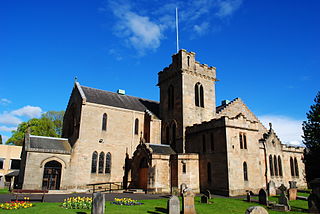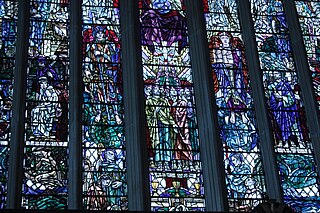
Clydebank is a town in West Dunbartonshire, Scotland. Situated on the north bank of the River Clyde, it borders the village of Old Kilpatrick to the west, and the Yoker and Drumchapel areas of the adjacent City of Glasgow immediately to the east. Depending on the definition of the town's boundaries, the suburban areas of Duntocher, Faifley and Hardgate either surround Clydebank to the north, or are its northern outskirts, with the Kilpatrick Hills beyond.

New Kilpatrick, is an ecclesiastical Parish and former Civil Parish in Dunbartonshire. It was formed in 1649 from the eastern half of the parish of Kilpatrick, the western half forming Old Kilpatrick. New Kilpatrick is also a disused name for the town of Bearsden.

Douglas Strachan is considered the most significant Scottish designer of stained glass windows in the 20th century. He is best known for his windows at the Peace Palace in The Hague, Netherlands, at Edinburgh's Scottish National War Memorial and in cathedrals and churches throughout the United Kingdom. He is also known for his paintings, murals, and illustrations.

John Baptist Crozier was a Church of Ireland bishop. He served as Bishop of Ossory, Ferns and Leighlin (1897–1907), Bishop of Down, Connor and Dromore (1907–1911), Primate of All Ireland and Archbishop of Armagh (1911–1920).

The Parish Church of St Cuthbert is a parish church of the Church of Scotland in central Edinburgh. Probably founded in the 7th century, the church once covered an extensive parish around the burgh of Edinburgh. The church's current building was designed by Hippolyte Blanc and completed in 1894.

Wilhelmina GeddesHRUA was an Irish stained glass artist who was an important figure within the Irish Arts and Crafts movement and also the twentieth century British stained glass revival. Notable works include windows at St Bartholomew's, St Peter's Church, and the King Albert Memorial Window, St Martin's Cathedral.
Daniel Cottier (1838–1891) was a British artist and designer born in Anderston, Glasgow, Scotland. His work was said to be influenced by the writing of John Ruskin, the paintings of the Dante Gabriel Rossetti and the work of William Morris. He painted allegorical figures in the Pre-Raphaelite style of Rossetti and Sir Edward Burne-Jones. Cottier is considered to be an important influence on Louis Comfort Tiffany and also is credited with introducing the Aesthetic movement to America and Australia.
Lilian Josephine Pocock (1883–1974) was a stained glass artist who provided stained glass for a number of buildings, including Ulverston Victoria High School, The King's School and Ely Cathedral. She was also a theatrical costume designer, book illustrator and watercolourist. In her later years, failing eyesight prevented her from continuing her work in stained glass. After some years of retirement she died in 1974.

Mabel Esplin (1874–1921) was an English stained glass artist.

Hugh Arnold was an English stained glass artist. Arnold was educated at the Slade School of Fine Art before attending the London County Council (LCC) Central School of Arts and Crafts where he studied under Christopher Whall from 1989 to 1903. He designed stained glass windows for James Powell & Sons and also did some independent work. While an officer in the Northumberland Fusiliers, Arnold died on active service at Gallipoli in 1915.
Herbert Hendrie was an English stained glass artist. He is known for his strong simple designs with scintillating jewel-like effects. Among his best-known works are the fifteen windows for Kippen church and the tall stained glass windows for Liverpool Cathedral.

Arthur "Mud" James Dingle was a rugby union centre and wing, who won three caps for England, and played for County Durham, Hartlepool Rovers and Oxford University.

St Margaret's Church is a Category B listed church of the Scottish Episcopal Church at 355 Kilmarnock Road, Newlands, Glasgow, Scotland.
James Cooper (1846–1922) was a Church of Scotland minister and church historian. In 1917 he attained the highest position in the Church of Scotland as Moderator of the General Assembly. He was a prolific author on religious topics and strong advocate of the reunion of the various schisms of the Scottish church.

Michael Healy was an Irish stained glass artist, one of a small number which included Wilhelmina Geddes, Evie Hone, and Harry Clarke, who achieved international recognition for their work in this medium in the first half of the 20th century. He also achieved some distinction as an illustrator and cartoonist early on in his artistic career, and as an ongoing recorder of Dublin street characters going about their daily business. Healy also occasionally painted in oil, both portraits and landscapes, exhibiting a small number of the latter during his lifetime.
Stephen Adam (1848–1910) was a 19th/20th-century Scottish influential stained glass designer. He was a pioneer of modern stained glass in Scotland. The majority of his work is in the Pre-Raphaelite style, often with a twist towards Celtic mythology, and is mainly sited in western Scotland. Although the bulk of his work is for churches he also received many secular commissions.

Sadie F McLellan was a Scottish stained glass artist known for her work in Robin Chapel and Glasgow Cathedral.
Art Nouveau temples are churches, chapels, synagogues, and mosques built in the style known as Art Nouveau in French and English languages, Jugendstil in Germany and Nordic countries, Secessionsstil in countries of former Austro-Hungary, Modernisme in Catalan, Modern in Russian, Stile Liberty or Stile Floreale in Italian. As National Romantic style is also referred to Art Nouveau, churches of that style are also listed here, as well as some temples not of pure Art Nouveau style but with distinctive Art Nouveau features.
Leonard Walker was a British painter and stained glass designer. His work was part of the painting event in the art competition at the 1928 Summer Olympics.

Websters is a theatre in Glasgow, Scotland. It also operates as a bar and restaurant. Websters occupies the building of the 19th century former Lansdowne Parish Church.












